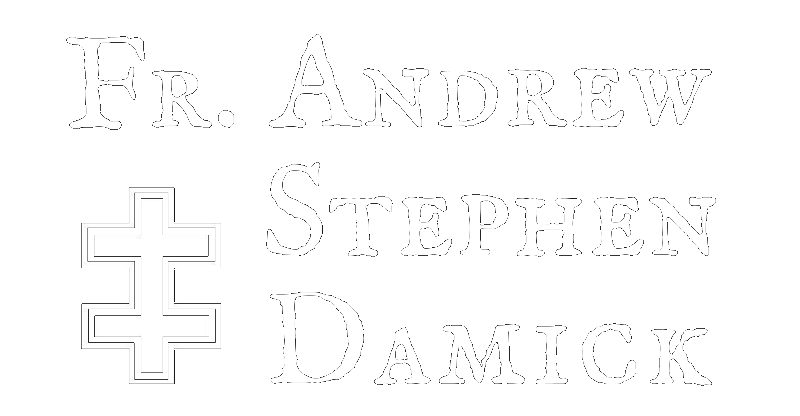
Elevation of the Cross, September 14, 2020
I Corinthians 1:18-24; John 19:6-11, 13-20, 25-28, 30-35
In the Name of the Father and of the Son and of the Holy Spirit, one God. Amen.
In the services for this great feast of the Elevation of the Cross, there is a theme that may escape our notice, which is the defeat of the Amalekites by Moses and the people of Israel. The people of Amalek are mentioned over and over in hymns pertaining to the Cross, not just for this present feast but in many of the hymns relating to the Cross throughout the whole church year.
It seems like an odd detail. Who was Amalek, and what do they have to do with the Cross?
In order to understand this theme, we have to go back to the Exodus, which is not only the second book of the Bible but also the account of the formation of Israel, the nation that God formed for Himself at the Passover, drawing people out of Egypt to create this new nation, saving them from slavery to the gods of Egypt.
In the Exodus, God gives to the Prophet Moses a wooden staff, referred to as the “Staff of God” (Ex. 4:20). With this staff Moses not only performs miracles in the presence of Pharaoh—who was understood to be a personification of the Egyptian god Horus—but it is also a symbol of his authority to rule and to judge Israel. Later Jewish tradition would identify this staff as being cut from the very Tree of Life in Paradise itself, giving it a mythic quality connecting it directly with God’s intimate and life-giving friendship with Adam.
It is with this staff that Moses and his brother Aaron strike the Nile and turn its waters to blood. And with this same Staff of God the various plagues of Egypt are brought upon them, an action brought against Egypt’s gods, who are being judged by God through Moses and this staff (Ex. 12:12).
This same staff is stretched over the Red Sea by Moses, parting it so that Israel might cross on dry land (Ex. 14:16). And it is brought into the wilderness and used to strike a rock to bring forth water (Ex. 17:5-6). Later, it buds forth miraculously with life to show that Aaron was chosen by God to be high priest (Num. 17:1-10) and was even placed with the Ark of the Covenant (Heb. 9:4) at the very center of the worship of Israel, alongside the miraculous bowl of manna and the tablets of the Law.
Before the staff buds or is placed with the Ark, however, it is held up by Moses in the wilderness when Israel—still wandering in the Sinai desert—is attacked by Amalek at a place called Rephidim (Ex. 17:9).
Who is Amalek? Amalek himself is a grandson of Esau, who was the brother of Jacob. And so the name Amalek is used to refer to this clan who are his descendants. And Amalek is one of the giant clans of the Old Testament, small nations of people who were led by human beings in a diabolical union with demons. The demonic powers they received from this union made them “giants” in the sight of the people, a term which in those days did not necessarily refer to large physical size but rather to ability and influence.
Amalek is mentioned about fifty times in nine books of the Old Testament, and it is not until the triumph of the Prophet-King David when they are finally defeated in full. The brief account of the defeat of Amalek at Rephidim is found in Exodus 17:8-16:
Now Amalek came and attacked Israel in Rephidim. And Moses said to Joshua, “Choose us some men and go out, fight with Amalek. Tomorrow I will stand on the top of the hill with the staff of God in my hand.” So Joshua did as Moses said to him, and fought with Amalek. And Moses, Aaron, and Hur went up to the top of the hill. And so it was, when Moses held up his hand, that Israel prevailed; and when he let down his hand, Amalek prevailed. But Moses’ hands became heavy; so they took a stone and put it under him, and he sat on it. And Aaron and Hur supported his hands, one on one side, and the other on the other side; and his hands were steady until the going down of the sun. So Joshua defeated Amalek and his people with the edge of the sword.
Then the Lord said to Moses, “Write this for a memorial in the book and recount it in the hearing of Joshua, that I will utterly blot out the remembrance of Amalek from under heaven.” And Moses built an altar and called its name, The-Lord-Is-My-Banner; for he said, “For a hand was lifted up to the throne of the Lord: the Lord will have war with Amalek from generation to generation.”
It is this action of Moses lifting up the Staff of God during the battle with Amalek that is the source of the many references to Amalek in our hymns for the Cross. As you can guess by now, the Staff of God is an image being joined by the Fathers who wrote our hymns to the image of the Cross of Jesus Christ. They did not make this association up, however. They were simply reading the Scripture and seeing what was there.
The defeat of Amalek by Israel, with Moses holding up the Staff of God, is not just a story of one army defeating another army. Remember that Amalek is one of the giant clans. It is, in other words, a people intimately involved with demons and led by people in union with demons. Israel’s defeat of this army is a defeat of demons.
Moses holding up the Staff of God at Rephidim is therefore a sign that Israel is serving as God’s own army, defeating God’s own enemies, who are the demons, fallen angels who rebelled against Him and were stirring up human beings to join this rebellion.
This same action happens when we hold up the Cross of Christ as we do during this feast and at many other times in our worship. The Cross is the very Staff of God, used to defeat His enemies, the demons. As we say at Pascha, “Let God arise and His enemies be scattered. Let them that hate Him flee from before His face” (Ps. 68:1).
In the Litia hymns sung at Great Vespers for this feast, we hear: “Prefiguring the power of Thy precious Cross, O Christ, Moses turned back the adversary Amalek in the wilderness of Sinai; for when he stretched out his hands, forming the figure of the Cross, the people prevailed. Now the outcome of these deeds is fulfilled for us. Today the Cross is exalted, and the demons are put to flight.”
This sign of the Cross is used by God through His people—whether Moses with Israel in Sinai or here today with us in this feast—to drive back His enemies the demons. There is no other sign that we need in order to put them to flight. We lift high the Cross, and the demons tremble. They have seen it before. They know that it is their defeat.
We wear the Cross on our necks. We make the image of the Cross on ourselves by making the sign of it on our bodies. We place the Cross on our holy temples and in our homes. We are blessed by the Cross by the bishop and the priest.
We do not make the Cross so prominent in our lives as a kind of brand to mark us out as Christians. Rather, it is by the Cross that we participate in the defeat of God’s demonic enemies, that we declare that we will not join their rebellion.
We especially see today that the Cross of Christ is placed on the holy altar, which is itself the presence of the Ark of the Covenant in our midst. And with it is the new Law, which is the Gospels. And also with it is the new manna in the wilderness, which is the Holy Eucharist.
The cosmic war between God and His enemies the fallen angels is going on all around us and even within us. And we have been given the Cross, the very Staff of God, as a weapon against the demons. With it, we deny the demons access to us, and we destroy their power over us, firmly placing ourselves on the side of the Lord, His angels and His saints.
To the Father, the Son and the Holy Spirit therefore be all glory, honor and power, now and ever, and unto ages of ages. Amen.




St. Justin also sees Joshua as manifesting Christ in the battle in that he led the army and his name was, in Greek of course, “Jesus”.
Right, Christ is the new or fulfilled Moses and Joshua and David.